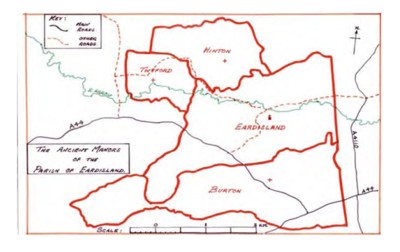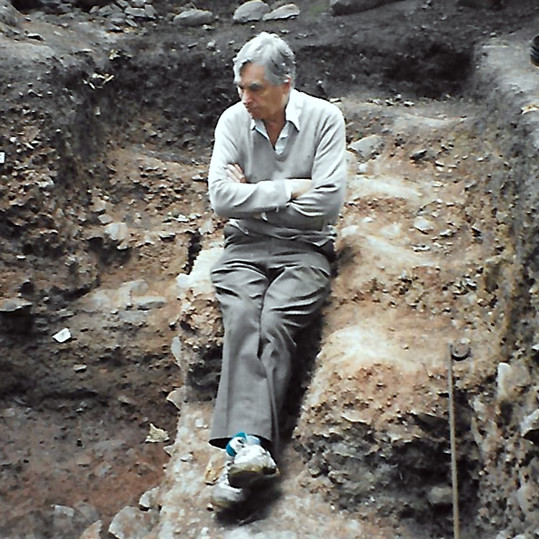Welcome to the parish history pages, which contain extensive articles on many aspects of Eardisland parish.
Most of the articles are provided as pdf files, for which you will need Adobe Reader which you can download here.

Map showing location of Manors
The area within the parish boundary has a complicated history, there being four ancient manors therein. This section is intended to be no more than a 'thumb nail' sketch. Much has been intentionally omitted.
There is no doubt that this area was settled in very early times. Herefordshire Sites and Monuments Record (SMR), lists 108 sites within this parish. Whilst only two of these are related there to pre 1066 [both to the Bronze Age], several others which are listed as undated are, by their very nature [eg 'Ring ditch'] also likely to prove, if investigated by archaeologists, of Romano-British or earlier date.
Other than the Roman road which largely forms the eastern boundary of the parish, there is scant archaeological evidence for the Roman period, nor is there evidence to suggest to what extent 'Romanization' altered the earlier cultural situation hereabouts.
The Roman era in Britain ended circa 410AD. By about 700AD (some say 600), the valley of the river Arrow and its immediate environs had been subject to occupation by an influx of "Anglians".
Time passed ....... by the time of the Battle of Hastings in 1066 the lands in this vicinity were held by Morcar, Earl of Northumbria. The administrative structures later known as the "manors" of Eardisland, Burton, Hinton and Twyford would have coalesced well before then, but the date of the establishment of a church here is much less certain.
The Norman Conquest took its course - without major struggle in this immediate area it is thought. Then in 1086 King William "The Conqueror" caused what soon became known as the Domesday Book to be compiled. Eardisland is to be found under the name of "Lene", held by the King himself. Burton, Hinton and Twyford are not mentioned.
In 1091 the King (by then William II "Rufus") gave a considerable amount of land in Herefordshire to William (i) de Braose of Bramber (in Sussex) which included our area. The four manors here continued to be held by the de Braose family as tenants-in-chief of the Crown until the execution of William (iv) de Braose by Llwyelyn the Great in 1230. His four daughters inherited different parts of his overall holdings, Maud (Matilda) being the eventual inheritor of this area. Maud married Roger, son of Ralph (ii) de Mortimer of Wigmore. The manors stayed as part of the very extensive Mortimer holdings until, by 1433, Hinton and Eardisland had become two of the two hundred manors held by Richard, Duke of York; these two in particular via Anne, widow of Edmund Mortimer, 5th Earl of March, sister-in-law of Richard’s mother, Anne Mortimer.
Of Twyford little is known in comparison with the other three. In 1425 Thomas le Poitevin was holding it forEdmund (iii), the last Mortimer Earl of March, and as comparatively recently as 1649 it is referred to as the Manor of 'Twyford and Broome'. There are other references, but this is not the place for them. A separate manor Twyford undoubtedly was.
The manor of Burton is well documented. The St Owen family were holding of the various tenants-in chief of the Crown already mentioned from very soon after the Conquest, and were at Burton until, between 1399 and 1404, the manor of Burton passed by marriage to the Downton family. Circa 1447, again by marriage, the Cotes family became lords of Burton and remained there until 1641 when the manor was sold to Henry Hyet (and others).
Hyet was removed from Burton in 1645, but by 1659 he was back in possession. He sold to John Brewster in April 1662. The Brewster family held until 1804 and were followed, yet again by marriage, by the Evans family. They held until 1863 when the manor was sold to a member of the Clowes family of Broughton Hall, Lancashire. The Clowes family were still in possession in 1922 when the Law of Property Act abolished all remaining manorial rights and privileges-and Copyhold tenure.
Hinton and Eardisland, after 1433, passed back to the Crown in 1459/1460 when an Act of Attainder was passed against Richard, Duke of York. He was executed without trial immediately after the Battle of Wakefield in 1460. Ten years or so later, in 1469-1471, both Eardisland and Hinton were being controlled and farmed directly by the Crown. In 1533-1535 there is record that both the manors of Hinton and of Eardisland belonged to Catherine of Aragon, then dowager of Arthur, late Prince of Wales.
After the death of Catherine of Aragon in January 1536 Hinton took more lowly ownership. In 1554 it was granted to Christopher Smyth and Mr. Barton, gentlemen..., - but the manor of Eardisland took a different course as recounted later. The Barton family fall out of the picture at Hinton after this one appearance, but the Smyth (Smith) family continue as lords of the manor of Hinton until the late 1630s, when the Hyet family make a brief appearance.
Not surprisingly the Civil War and Commonwealth period have produced no written record of the manor of Hinton- indeed the story does not pick up again until 1713 when the Cutler family, (Robert) is found as lord of the manor. That family is followed from 1734 by the Crowther family until 1791; Sanders family c.1864 to c.1903; and the Paton family c.1909 to 1924; by which time the Law of Property Act of 1922 had abolished the remaining rights and privileges of lords of the manor - most importantly land tenure by Copyhold.
By 1553 the manor of Eardisland is again recorded as being held by the Crown, [in the person of Queen Mary (Tudor)], but whether it came to her via her mother[Catherine of Aragon] or by her father [King Henry VIII] is not yet discovered.
During Mary's reign the Devereux family, Earls of Essex, became tenants-in-chief of Eardisland. Then from 1653, possibly earlier, it was held by the eldest son of the Marquis of Bath with whose descendants it remained until sold, in 1802, to James Kinnersley. The Kinnersleys were followed as lords of the manor of Eardisland by the Smythies family from circa 1811 until 1851, then, from circa 1863 by John Harding until his death in about 1891.
Some notable names have been recorded in this summary of the lordship of the four manors within the parish. But what of the other many, many families who lived, worked and died here over the centuries? And what of the buildings they lived in, the land they held of the manors, the fields in which they toiled; and indeed of the church in which they worshipped? This list could continue... but the point is made.




